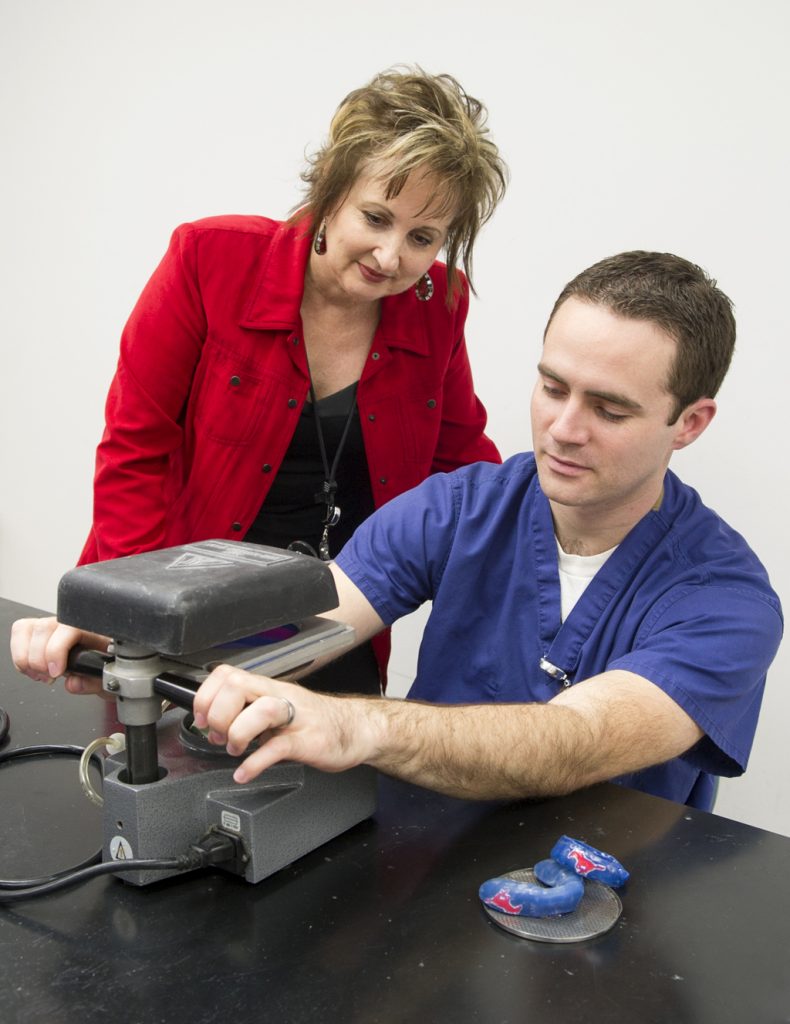Progress notes

Ballroom dancing, basketball and bicycles — advocating mouthguards for all sports and seasons

Of the scores of professional sports today, only three — hockey, boxing and lacrosse — require athletes to wear mouthguards.
As a fellow of the Academy for Sports Dentistry and a member of its board of directors, Dr. Danette McNew ’88 spends part of each day educating patients on the value of mouthguard use for all sports, whether as part of a community team, youth league or recreational pursuit. How patients spend their spare time becomes a part of every conversation at her Rockwall, Texas, general dentistry practice.
On days when McNew isn’t at her office, she’s right here at Texas A&M University Baylor College of Dentistry, working with dental students in the clinic. Summers are spent teaching a sports dentistry selective, something she has done since 1995. Each week, she covers material ranging from sports injury risks to dentistry marketing practices, but the highlight is the trip to Southern Methodist University, where McNew and students take dental impressions of the football players and fabricate their mouthguards. This year the SMU female soccer and basketball teams were thrown into the mix.
Now we hear more from this sports dentistry veteran — and Olympic Team USA dental provider — on the sports that pose the greatest risk to your pearly whites, the options for protecting them and just how to integrate sports dentistry into the modern dental practice.
NewsStand: Are certain sports inherently more hazardous for your teeth than others?
McNew: High impact sports are, definitely. Anything that has an athlete at high speeds impacting something, whether it’s another athlete or a piece of equipment — think lacrosse, hockey, football, basketball, boxing, karate and taekwondo.
Then there’s bicycling. There are many who tumble off of bicycles, racing bikes especially. As well, people probably don’t think of waterskiing falls as a traumatic injury, but we‘ve seen cases of teeth being knocked out. Even ballroom dancing — you’re in a mix of people who might not see where they’re going. There can be a collision and actual mouth trauma on ballroom dancing floors.
NewsStand: Tell us about choices in mouthguards. How are they made differently for different sports?
McNew: There are three types of mouthguards. There is over the counter, which offers very minimal protection and is not very comfortable to wear. The next one is a boil-and-bite mouthguard that you can heat up and fit around your teeth. That type can work for a while, but when people form the mouthguards themselves they may not get the right fit. Then of course the custom mouthguards that we are talking about, which are made by the dentist who takes the impression of the athlete’s teeth and then forms the mouthguards over the model or cast.
Mouthguards can be adapted to different sports because each calls for different protection. In football, linebackers clench down on their teeth because they are prepping to take blows, so you need thickness in the posterior chewing region. With basketball, it needs to be thicker in the front because those athletes are taking elbows to the face. You can adapt and thicken the material to the particular sport. That’s why custom is better than over the counter or boil and bite.
NewsStand: What can go wrong when making mouthguards? How do you help students in your selective course prevent mishaps?
McNew: You can overheat the material, ethylene vinyl acetate. It can be overheated and overlap when it’s placed on the cast. It can get bubbles. It can be underheated.
The very first step is taking a correct impression. The selective junior students are still not refined in taking impressions. My goal is to build on that base they already have. Once you have an adequate impression you have to trim it correctly. Trimming the base is really important because the vacuum of the machine is adapted to that cast.
NewsStand: How do you integrate sports dentistry into your practice?
McNew: At my practice my job is to inform patients and make parents aware they need this protection for their kids, from young athletes just goofing around in their driveway and having a mobile basketball goal fall down on their teeth to weight lifters clenching their teeth. I always recommend they wear mouthguards to decrease dental injuries and excessive wear.
I try to find out from my patients what they do in their spare time, whether it’s mountain climbing, water rafting, etc. I always suggest protection for my patients, regardless of age, and yet I usually do not suggest mouthguard protection for my geriatric patients unless they are preparing for surgery. Otherwise, they may come back with broken teeth or crowns because they compress their teeth on tubes placed into the throat during surgery. Mouthguards should be an essential component of our patients’ lives.
Students or alumni interested in team dentistry may contact McNew at dmcnew@tamhsc.edu or at her Rockwall office at 972-771-2213.
—Jenny Fuentes